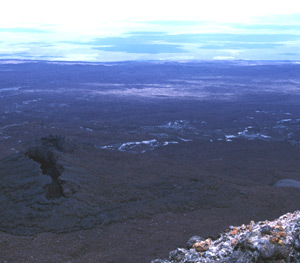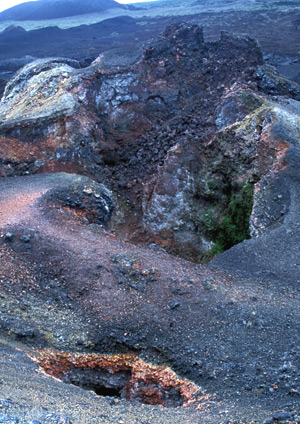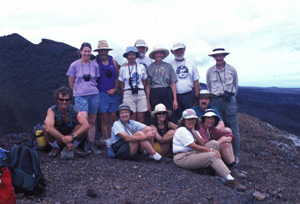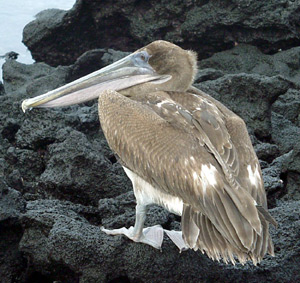We left quite early in the morning and landed in the harbor of Puerto Villamil. It appears to be somewhat more prosperous than Ibarra, and there was actually work under way paving the sidewalks in the downtown area. At the landing, we saw a Franklin's and a Thayer's Gull. The Thayer's was an easy call but, according to Desiree, the first one reported in the Galapagos Is.
We climbed into another set of cattle trucks and drove up to the highlands of Vol. Sierra Negra (also called Vol. Santo Tomas). We had lots of truck problems, and eventually required rescue by a second truck, but finally made it up to a small set of ramshackle buildings a few hundred feet below the caldera rim on the outer slopes of the volcano. We got ourselves mounted up on horseback. The horses were pretty tired; the saddles were thin leather over - no fooling - concrete rebar frames. I wore long pants for the first time on the trip and was very glad I did. Even so, my butt will remember the ride for a long time.
We rode a gentle slope up to the rim of the caldera itself. The caldera is huge, perhaps 6 miles across. From the upper rim it appears flat, but given the history of activity I suspect it is rugged lava. I'd guess it was at least 200 feet down to the crater floor, but there is nothing to give you perspective to tell for sure.
We rode along the rim, seeing Dark-billed Cuckoo and Galapagos Martins. We left the horses under the biggest trees I'd seen in the Islands, and walked - well, limped - on east across increasingly younger lava flows to Volcan Chico, the site of a 1979 eruption. It was a textbook lesson in eruption geology. Lava river channels, vents, cinder cones, collapsed lava tunnels, collapsed parasitic cones, kipuka; everything you would expect to see. The walk turned around at some steam vents that might as easily have been in Hawaiian Volcanos National Park, lush with ferns and plants, and the rocks crusted with sulfur and other, less easily identified mineral deposits.
The walk back was nice, under threatening skies that never rained, but the horseback ride was brutal. I am not designed for horseback riding, and Nancy's saddle-making friend, Lyle Stilwill, would have blanched in horror at the "saddles" and the rest of the tack. Next time I think I'll walk.
All the trucks ran on the ride back down, and at the shore a full-fledged community swim was under way. Lots of swimming and splashing under way.
In the late afternoon, we waked to the lagoons behind the village, seeing Greater Flamingos and Common Moorhen. A good selection of shorebirds, including Semi-palmated Sandpiper, Least Sandpiper, Ruddy Turnstone and Cattle Egret. Beyond the lagoons there was a very nice, very new boardwalk which leads to a tortoise breeding facility in the arid zone. The boardwalk is probably the nicest I've seen anywhere, with excellent views of the lagoons and the drier areas beyond the lagoons. Special treats included a Black-necked Stilt with two chicks, a Blue-winged Teal with five chicks, and a pair of Barn Owls having an early twilight snack on Painted Locusts.
|
Birds
|
Others
|
| Magnificent Frigatebird Ruddy Turnstone Wandering Tattler Thayer's Gull Franklin's Gull Striated Heron Lava Heron Lava Gull Galapagos Martin Brown Pelican Black-bellied Plover Dark-billed Cuckoo Whimberel (12) Common Moorhen Greater Flamingo Semi-palmated Sandpiper Least Sandpiper White-cheeked Pintail Black-necked Stilt Cattle Egret Barn Owl Yellow Warbler Small Ground Finch Medium Ground Finch Smooth-billed Ani Galapagos Flycatcher Galapagos Mockingbird Blue-winged Teal Blue-footed Booby Brown Pelican Audubon Shearwater |
Lava Lizard Marine Iguana Galapagos Sea Lion |



